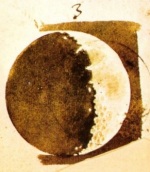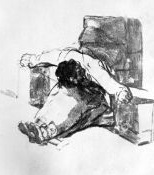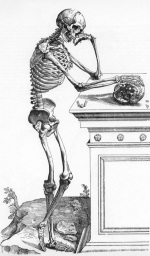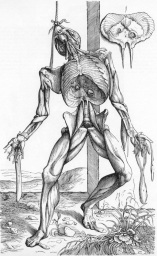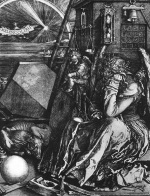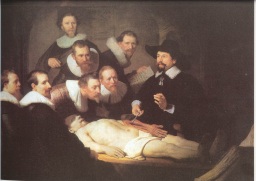![]()
The Starry Messenger appeared in 1610, a demonstration of convergence of two worlds, the material, changeable world within the orbit of the changeable moon, and the celestial world above. Looking through Galileoís eyes, enhanced with telescopic vision, observers now compare the play of light on Tuscan peaks at dawn and the enlargement of spots of light on the face of the moon. Galileoís Starry Messenger, no longer the angel of annunciation, takes shape as a physical body, with features visible and measurable by just the means developed for encompassing the earth. In 1543 Nicolaus Copernicus had published a theory of revolution with the sun, not the earth, at the center of planetary motion. Copernicus, however assumed circular orbits, and his theory given that assumption was less accurate then traditional views. Galileo also held to circular motion as self-evident, Not until 1618 would Johannes Kepler publish his discovery that orbits are ellipses. But Galileo did demonstrate that terrestrial and celestial measurements followed the same law. His demonstration appealed to educated ecclesiastics, but imagined effect on general audiences led to his forced recantation, his forced confession that his view was no more than a theory. In his personal notebook, during a bleak time in Spanish history, Goya calls upon the spirit of Galileo (tied down by inquisitors, but inwardly inquisitive still, to revive his faith in reason. The Indigo Girls two centuries later seek similar solace and energy.
Eratosthenes and others provided Galileo with insights crucial to his developing insight.
Andreus Vesalius in 1542, a year before Copernicus published his account of revolution, published his account of the inner world, De fabrica corporis humani (the structure of the human body), While Galileo invited consideration of moonlight through geometry, Vesalius considered how to get moonlight into a chamber, how the fabric of the human body develops insight.
Vesalius, from his 1542 publication, De fabrica corporis humani (the structure of the human body), still invites viewers to unravel the mystery of flesh and spirit. The anatomist will perish, but the vision he shaped in life lives on in inherited memory. Vesalius as a Christian, shares horror and empathy confronting the end of sin: the cadaver revealing the mysteries of anatomy was hanged, perhaps for murder. Vesalius, himself himself a sinner, works to reveal the workings of mankind.
Vesalius, De fabrica corporis humani
![]()
At seventeen, twenty three years early, Vesalius would have studied the famous engravings by Albrecht DŁrer, Knight, Time and Death, and Melancholy.
A century later, in 1632, a dozen years after William Harvey published De Motu Cordis, demonstrating the circulation of blood through the heart, Rembrandt would commemorate Vesaliusí exploration of bodily fabric and psychic consequence. The Anatomy lesson of Dr. Tulp engages his seven disciples, sufficiently prominent to identify themselves on the notes held by one viewer. Dr. Tulp and Rembrandt, like Vesalius, relied on a hanged man, in this case a known murderer. To murder or to create: both possibilities inhere in free will, in every Dutch burgher as much as in every Dutch criminal. Open to our inspection, a sinister (left) hand draws memories. But this hand has the configuration of the opposing hand, its dexterity (right) calls for attention. Is the good physician displaying for us the sinful nature of the convict, with the possibility of using anatomical and civic understanding to improve Dutch society? Or is the good physician displaying the vanity of just such attempts? Traditional assumptions about human limitations vie with current hopes for progress through rational analysis.
Players and Musicians
A generation later in England, the hanging of criminals provided entertainment, with the acting out of the wages of sin. On the one hand, the removal of a criminal reduced crime, and the spectacle of retribution was designed to discourage further predations. But such a sinner also was one among us all, and the popular song Fortune my Foe became the accompaniment to hanging. Not just for the criminal is fortune the foe.
Born in the year Vesalius published De fabrica caporis, the English composer William Byrd composed his own variation on the hanging song, Fortune my foe. Among the few Catholic composers of his day, he continued to compose and perform in Protestant England. In 1605 the discovery of of tunnels and gunpowder under the Houses of Parliament brought Guy Fawkes to the gallows. Catholics, assumed subversives, were hanged, and others fled to the relative tolerance of Holland. English Catholic composers, viewed as practitioners of Popish aggrandizement in England, also fled England, often to Holland.
In London theatres clowns would play upon pretensions to power and prosperity, and in Queen Elizabethís day Richard Tarleton served as her cherished jester. Tarleton died in 1588, but among his memorable performances is his posthumous engagement with Hamlet, as vivid in Hamletís memory as Alexander or Caesar:
Horatio
This same skull,
sir, was Yorick's skull, the king's jester.
Hamlet
This?
First Clown
E'en that.
Hamlet
Let me see.
Takes the skull
Alas, poor Yorick! I knew
him, Horatio: a fellow
of infinite jest, of most excellent fancy: he hath
borne me on his back a thousand times; and now, how
abhorred in my imagination it is! my gorge rims at
it. Here hung those lips that I have kissed I know
not how oft. Where be your gibes now? your
gambols? your songs? your flashes of merriment,
that were wont to set the table on a roar? Not one
now, to mock your own grinning? quite chap-fallen?
Now get you to my lady's chamber, and tell her, let
her paint an inch thick, to this favour she must
come; make her laugh at that. Prithee, Horatio, tell
me one thing.
Horatio
What's that, my lord?
Hamlet
Dost thou think Alexander looked o' this fashion i'
the earth?
Horatio
E'en so.
Hamlet
And smelt so? pah!
Puts down the skull
Horatio
E'en so, my lord.
Hamlet
To what base uses we may return, Horatio! Why may
not imagination trace the noble dust of Alexander,
till he find it stopping a bung-hole?
Horatio
'Twere to consider too curiously, to consider so.
Hamlet
No, faith, not a jot; but to follow him thither with
modesty enough, and likelihood to lead it: as
thus: Alexander died, Alexander was buried,
Alexander returneth into dust; the dust is earth; of
earth we make loam; and why of that loam, whereto he
was converted, might they not stop a beer-barrel?
Imperious Caesar, dead and turn'd to clay,
Might stop a hole to keep the wind away:
O, that that earth, which kept the world in awe,
Should patch a wall to expel the winter flaw!
John Dowland, a composer and lutenist as appreciated for music as Shakespeare was for drama, and much more highly paid, shared his experiences of melancholy. Semper Dowland, semper dolan (Always Dowland, always dour) and Lachrymae variations ( Seven Tears) found favor eventually leading Dowland from London to Denmark to serve the Danish Court. Dowland no doubt appreciatied his predecessor Richard Byrd, and Byrd. Tarletonís Risurection recalls the clown, not to rise above worldy cares, but to appreciate our fragile anatomy.
Tarletonís Resurrection
![]()
Music as Art and Science
Musicís
power to move listeners, to dance, to emotive states, to the recollection
of events, coexists with underlying structure. Galileo calls attention to
the book of nature, most clearly evident in astronomy, by identifying the
language in which it is written: the language of numbers. Galileo grew up
with music. His father Vicenzo, a lutenist and composer, was among the
foremost musical theorists of his time. The Galileo who observed during a
service in Florence Cathedral the swinging of a chandelier, swaying more
or less swiftly as breezes swirled, used his pulse, that standard of fast
and slow, to recognize that the time for swinging back and forth did not
vary, however little or great the distance traveled. Galileoís eye, ear
and intellect were refined and integrated, an integration essential for
the scientist as well as the musician.
Guillaume Machaut, the first composer to leave a full musical setting of the mass, linked immediacy of impression with sophisticated structure. In the mid 1300s, he creates the experience of divine order combined with human frailty in his canon Ma fin est mon commencement (My end is my beginning). The soprano voice sings from beginning to end. The tenor accompanies, singing from end to beginning. The independent alto voice part proceeds halfway, then proceeds backwards to end on its own beginning.
Ma fin est mon commencement ![]()
Bruneleschiís great dome, a marvel equally to sight and to intellect, completed the Cathedral of Maria del Fiore in Florence. Celebrating the dedication of the cathedral on March 25, 1436, Guillaume Dufayís Nuper rosarum flores offers an auditory accompaniment to the visual graces of Maryís dwelling. His variation on sound and sense suits the occasion. His Virgine Bella, also in praise of the Virgin, offers a more intimate variation on sound and sense.
But the evidence of harmony between earthly music and the music of the spheres came under the same scrutiny that Galileo applied to temporal and celestial assumptions. Like The Starry Messenger, the message of harmony is subject to volution.
Francis Bacon had indicated the dangers of tradition in his attack on four idols:
The astonishing consequence of Baconís project takes shape in Charles Darwinís Origin of Species:
Darwinís
Survival of the Fittest
![]()
